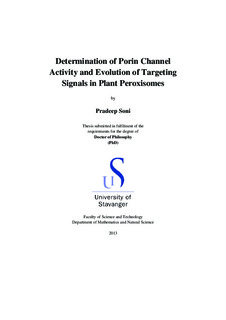| dc.contributor.advisor | Ruoff, Peter | |
| dc.contributor.author | Soni, Pradeep | |
| dc.date.accessioned | 2018-04-26T11:05:27Z | |
| dc.date.available | 2018-04-26T11:05:27Z | |
| dc.date.issued | 2013 | |
| dc.identifier.citation | Determination of porin channel activity and evolution of targeting signals in plant peroxisomes by Pradeep Soni, Stavanger : University of Stavanger, 2013 (PhD thesis UiS, no. 184) | nb_NO |
| dc.identifier.isbn | 978-82-7644-521-3 | |
| dc.identifier.issn | 1890-1387 | |
| dc.identifier.uri | http://hdl.handle.net/11250/2496110 | |
| dc.description.abstract | Peroxisomes are eukaryotic organelles traditionally known for their roles in fatty acid metabolism and generation and removal of hydrogen peroxide. Several new functions are being ascribed to these organelles with the help of genetic and proteomic based studies. Despite showing the diversity in metabolic functions, peroxisomes from different sources share certain common features related to protein import pathways and the transfer of metabolites across them.
The majority of peroxisome matrix proteins are imported by peroxisome targeting signals PTS 1 and 2. All the proteins containing PTS2 have been found to be replaced by PTS1 in C.elegans and P.tricornutum suggesting higher preference to PTS1 in these organisms. One aim of the present study was to determine if a similar transition of targeting signals from PTS2 to PTS1 has also occurred in plants during the course of evolution. This was studied by taking protein orthologs from both lower photosynthetic organisms including mosses and algae and higher plants containing monocots as well as dicots. In total five groups of proteins could be constructed assuming an increased affinity to PTS1 in higher plants and their targeting signals were analyzed by in vivo subcellular localization studies. The results showed a higher preference to PTS2 signal by proteins from lower plants while the corresponding protein sequences from higher plant orthologs displayed higher affinity to PTS1 signal. It is also suggested that the evolution of targeting signals in plants may not end to exclusive PTS1 proteins like C.elegans but rather dual signal proteins containing both PTS1 and PTS2 signals either on one protein or on two different but interacting proteins.
The peroxisomal membranes are predicted to contain the porin like channels that regulate the transfer of solutes involved in various metabolic reactions. However, the molecular basis of such a channel in plants is not known. Thus, the leaf peroxisomes were isolated from Arabidopsis and subjected for electrophysiological characterization with the help of planar lipid bilayer technique. The results showed the pore forming activity in the peroxisomal membrane fractions with the average single channel conductance corresponding to 0.5 nS in 1 M KCl. In addition, two peroxisomal membrane proteins AtPMP22 and AtPEX11-D were also overexpressed using Pichia as a heterologous system and were subjected for lipid bilayer analysis. The experiments suggested a porin activity in the purified fractions containing the recombinant proteins.
The study presented in this thesis will help to understand the evolution of targeting signals in plant peroxisomes and may expand our knowledge related to protein import pathways. The pore forming activity observed in Arabidopsis leaf peroxisomes and in the overexpressed recombinant proteins AtPMP22 and AtPEX11-D may help in better understanding of porin channels in plant peroxisomes and also in finding the molecular basis of the reported channel activity. This in turn may shed more light on our current information about transport properties of this organelle. | nb_NO |
| dc.language.iso | eng | nb_NO |
| dc.publisher | University of Stavanger, Norway | nb_NO |
| dc.relation.ispartofseries | University of Stavanger, Norway; | |
| dc.relation.haspart | Research paper: Babujee, L., Wurtz, V., Ma, C., Lueder, F., Soni, P., Van Dorsselaer, A., Reumann, S. (2010). The proteome map of spinach leaf peroxisomes indicates partial compartmentalization of phylloquinone (vitamin K1) biosynthesis in plant peroxisomes, Journal of Experimental Botany, 61, 1441-1453.The proteome map of spinach leaf peroxisomes indicates partial compartmentalization of phylloquinone (vitamin K1) biosynthesis in plant peroxisomes. | nb_NO |
| dc.rights | Copyright the author, all right reserved | |
| dc.subject | proteiner | nb_NO |
| dc.subject | organeller | nb_NO |
| dc.title | Determination of porin channel activity and evolution of targeting signals in plant peroxisomes | nb_NO |
| dc.type | Doctoral thesis | nb_NO |
| dc.rights.holder | © Pradeep Soni | nb_NO |
| dc.subject.nsi | VDP::Matematikk og Naturvitenskap: 400::Zoologiske og botaniske fag: 480 | nb_NO |
